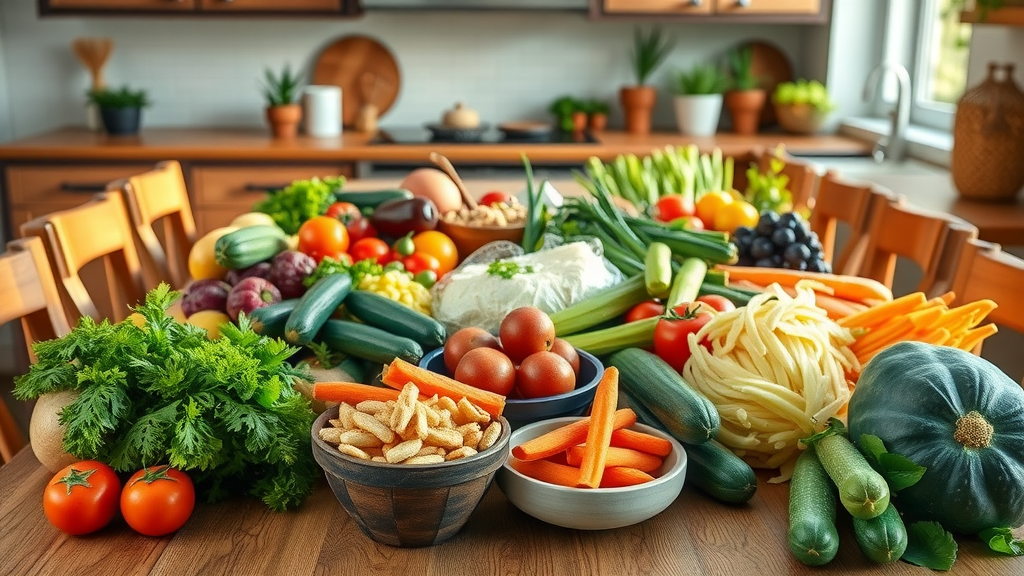Did you know that the number of vegans in the United States has increased by an astonishing 300% in the last 15 years? The path to a vegan lifestyle is not just a diet change—it’s a transformative journey. If you’re ready to embrace the benefits for your health, the environment, and animal welfare, this comprehensive guide will show you how do I become a vegan , making the switch easy and sustainable!
Unlocking the Vegan Lifestyle: Surprising Statistics and the Path Forward

"Did you know that the number of vegans in the United States has increased by an astonishing 300% in the last 15 years? The journey to veganism is not only about food—it's a transformative lifestyle that supports health, the environment, and animal welfare."
The surge in people adopting a vegan lifestyle speaks volumes about today’s focus on health, environmental sustainability, and animal rights. Research shows that more people than ever are searching for “ how do I become a vegan ” and making practical changes to eat food that reduces environmental impact, supports animal welfare, and promotes personal well-being. Adopting a vegan diet isn’t just about cutting out animal products; it’s about embracing a wide variety of nourishing plant foods that help you feel energized, support weight loss goals, and decrease risks of chronic conditions.
The vegan journey is also deeply personal. Whether you’re inspired by the health benefits, ethical values, or the vibrant community, making the switch is about progress—not perfection. With easy-to-follow strategies and a step-by-step approach, anyone can successfully adopt and thrive on a vegan diet. Let’s uncover what you’ll gain from learning exactly how to become a vegan —and why it matters now more than ever.
What You'll Gain by Learning How Do I Become a Vegan
-
Clear, accessible steps for starting a vegan diet
-
Practical strategies for transitioning to a vegan lifestyle
-
Nutrient essentials for balanced vegan diets
-
Tips for shopping, meal prep, and vegan recipes
-
Guidance on overcoming common vegan challenges

How Do I Become a Vegan: First Steps to a Vegan Diet
Understanding the Vegan Lifestyle: More Than Just Food
When considering how do I become a vegan , it’s crucial to understand that veganism extends well beyond what you put on your plate. The vegan lifestyle is rooted in the avoidance of all animal products, encompassing food as well as other daily purchases such as clothing, cosmetics, and cleaning supplies. By choosing plant-based alternatives, vegans strive to support animal welfare and reduce their environmental impact, all while benefitting their own health. A commitment to a vegan diet also involves mindful awareness of how food is produced and being intentional about sustainable choices.
Living a vegan lifestyle means making continuous improvements in your choices, from selecting whole, minimally processed plant foods at meal times, to advocating for cruelty-free options in body care, household items, and beyond. This approach creates positive change not only for yourself but also for the planet and animals. Remember, veganism is a journey—adopt new habits at your own pace and celebrate each progress, big or small.
Assessing Your Motivation for a Vegan Diet and Lifestyle
The most successful transitions to veganism are anchored in personal motivation. Ask yourself: Why do you want to follow a vegan diet ? Is it for health reasons, ethical concerns about animal treatment, environmental sustainability, or all three? Reflecting on your “why” will sustain you through any challenges. Jot down your reasons in a journal—whether it’s to improve your blood sugar, support weight loss, eat food that feels good, or align your actions with your values.

Having clarity on your motivation can transform temptations or setbacks into learning opportunities. When you remind yourself why you chose the vegan lifestyle , those challenging moments, like passing up a favorite non-vegan dish or facing questions from friends, become easier to manage. Your personal reasons will empower you to stick with your commitment and enjoy the journey.
Transitioning To a Vegan Diet: Step-by-Step Guide
-
Identify animal-based foods in your current diet: Make a list of the non-vegan foods you regularly eat, such as dairy, eggs, meat, and processed foods containing animal-derived items.
-
Begin substituting vegan food options: Swap out animal products with accessible vegan alternatives like plant-based milk, vegan cheese, or vegan burgers.
-
Gradually increase plant-based meals: Include more vegan food in your weekly rotation, starting with a vegan breakfast or lunch, and expand slowly.
-
Find vegan recipes you enjoy: Explore new dishes—try making a vegan version of your favorite foods. Use online resources and cookbooks to keep your meals delicious and varied.
Transitioning to a vegan diet doesn’t need to happen overnight. Many people find that a gradual approach makes the lifestyle shift more manageable and enjoyable. Set small, achievable goals each week and experiment with different plant foods for a rich and satisfying experience.
If you’re interested in exploring the broader health benefits of plant-based eating and how it can enhance your overall well-being, you might find this guide on embracing a plant-based diet for better health especially helpful as you continue your journey.
Plant-Based Basics: What Foods Do Vegans Eat and Avoid in the Vegan Diet
Essential Vegan Food Groups for a Balanced Vegan Diet
|
Food Group |
Examples |
Nutritional Benefits |
|---|---|---|
|
Legumes |
Lentils, Chickpeas |
Protein, Iron |
|
Whole Grains |
Quinoa, Oats |
Energy, Fiber |
|
Vegetables |
Broccoli, Kale |
Vitamins and Minerals |
|
Fruits |
Berries, Oranges |
Antioxidants, Fiber |
|
Nuts & Seeds |
Almonds, Chia Seeds |
Fatty Acids, Protein |

A successful vegan diet centers around a wide variety of plant foods. From legumes and whole grains to nuts, seeds, fruits, and vegetables, each food group offers unique health advantages. Legumes like lentils and chickpeas are packed with protein and iron , while whole grains provide lasting energy and support balanced blood sugar. Colorful fruits and vegetables offer essential vitamins and minerals , with deep greens like kale and broccoli contributing to bone and immune health.
Nuts and seeds deliver beneficial fatty acids , such as omega-3s, and are excellent sources of plant-based protein. These foods not only make your meals satisfying but also tackle nutritional needs often queried in vegan diets—like how to replace animal protein and meet daily nutrient targets. With smart planning, you’ll never miss out on key nutrients while enjoying a healthy diet full of flavor and variety.
Foods Vegans Avoid and Why
-
Meat and poultry
-
Fish and seafood
-
Dairy products
-
Eggs
-
Honey
-
Animal-derived ingredients in processed foods
Those who follow a vegan diet exclude anything sourced from animals. This means forgoing meat, poultry, fish, and seafood as protein sources. Dairy products like milk, cheese (including vegan cheese alternatives), yogurt, and eggs are also not eaten in a vegan diet. Vegans even avoid ingredients such as honey and scrutinize food labels for hidden animal products in seemingly “plant-based” processed foods—think gelatin, whey, casein, and some food colorings.
For many, the decision hinges on ethical considerations, environmental impact, or health concerns such as reducing saturated fat intake and promoting healthy blood sugar levels. It can be surprising to see how many processed foods harbor animal-derived ingredients, underlining the importance of mindful shopping and meal planning.
Understanding Vegan Labels and Ingredients

Deciphering food labels is essential for anyone learning how do I become a vegan . Look for official vegan certifications on packaging and always review ingredient lists for hidden animal products—these can include ingredients like gelatin, shellac, carmine, and certain E-numbers. Knowing the difference between “vegan,” “plant-based,” and “vegetarian” labels helps ensure every purchase aligns with your values and dietary goals.
Thankfully, demand for vegan food options has encouraged brands to clearly mark products and create vegan versions of old favorites—from vegan burgers to creamy plant-based yogurts or vegan cheese. Still, a little vigilance goes a long way, and with practice, you’ll find shopping for your vegan lifestyle becomes second nature.
Planning a Healthy Vegan Diet: Meeting Key Vitamins and Minerals
Critical Micronutrients and Maintaining Your Health on a Vegan Diet
-
Vitamin B12
-
Iron
-
Calcium
-
Vitamin D
-
Omega-3 Fatty Acids
-
Zinc
One key to thriving while you follow a vegan diet is understanding your micronutrient needs. Some nutrients—like vitamin B12, iron, calcium, vitamin D, omega-3 fatty acids, and zinc—are more challenging to get exclusively from plant foods . Vitamin B12, crucial for red blood cells and nerve function, is not present in unfortified plant foods, so look for fortified foods or supplements. Meanwhile, iron from plant sources (like lentils and tofu) can be enhanced by pairing with vitamin C -rich foods to boost absorption.
Calcium is found in leafy greens, fortified plant milks, or tahini, while vitamin D, often synthesized through sunlight or fortified foods, is especially important for those with limited sun exposure. Omega-3 fatty acids are derived from flaxseed, chia, and walnuts, supporting heart and brain health. With basic knowledge and planning, meeting daily requirements for these vitamins and minerals becomes simple and achievable.
How to Get Enough Protein and Fatty Acids on a Vegan Diet
|
Nutrient |
Vegan Source |
Daily Value |
|---|---|---|
|
Protein |
Tofu, Lentils, Tempeh |
50g |
|
Fatty Acids |
Walnuts, Flaxseed, Chia |
1.1-1.6g Omega-3 |
A common question is how to consume enough protein and healthy fats on a vegan diet. Plant sources like tofu, tempeh, lentils, and beans offer abundant protein to help you build and maintain muscle, support blood cells, and keep you feeling full. Nuts and seeds—including flaxseed, walnuts, and chia—are packed with omega-3 fatty acids, which are important for reducing inflammation and optimizing heart health.
Include a mix of these protein- and fat-rich foods daily for optimal energy, mood, and vitality. While highly processed vegan food and vegan burgers may appeal to newer vegans, focus primarily on whole sources for the best results. A little olive oil or avocado can also boost fatty acid intake and help with absorption of fat-soluble vitamins.
Supplementing Smartly: Do Vegans Need Supplements?

While a well-planned vegan diet covers most needs, some nutrients—especially vitamin B12—are best ensured through supplements. B12 is vital for healthy red blood cells and neurological function, and deficiency can lead to serious health issues. Many vegans also choose to supplement vitamin D (particularly in winter), omega-3 fatty acids (algal oil), and sometimes iron or calcium, depending on their individual health profiles.
Always consult with a healthcare professional before starting any supplement regimen and tailor your approach based on routine blood work. Smart supplementation alongside a varied, balanced diet helps you thrive and feel your best on your vegan journey.
Vegan Food Shopping: Essential Tips for a Vegan Lifestyle
Building a Vegan-Friendly Pantry and Grocery List
-
Staples: beans, lentils, rice, oats
-
Nuts, seeds, vegan spreads
-
Plant-based milk
-
Fresh and frozen produce
-
Ready-made vegan products
Stocking your kitchen is one of the best ways to simplify your transition and help you eat vegan daily. Fill your pantry and fridge with staples such as beans, lentils, rice, and oats. Have a rotating stash of nuts, seeds, and vegan spreads (think hummus or nut butters), plus plant-based milks for cereals or smoothies. Fresh and frozen fruits and vegetables ensure you’ve always got nutritious options on hand, and a few favorite ready-made vegan products—like vegan cheese or vegan burgers—can save time and satisfy cravings.
Building a vegan-friendly pantry means you’re never caught off guard, whether you’re preparing a quick lunch or a feast for friends. Use your grocery store visits to discover new plant foods and experiment with global flavors, making your meals both nutritious and exciting.
Navigating Hidden Animal Ingredients in Packaged Foods

Even in the age of clear vegan labeling, many packaged products contain hidden animal ingredients. Read ingredient lists carefully for non-obvious items like gelatin, casein, whey, and unexpected animal-derived additives. Certain colorings, stabilizers, and flavorings may also be sourced from animals, so when in doubt, look up unfamiliar terms online or choose products with certified vegan badges.
With a bit of practice, navigating the grocery store becomes more intuitive, and you’ll start to recognize which brands regularly offer vegan food options and which products require extra scrutiny. This diligence ensures your vegan diet fully aligns with your goals.
Meal Planning and Vegan Recipes for a Successful Vegan Diet
Simple Vegan Recipes to Start Your Vegan Journey
-
Breakfast: Overnight oats with almond milk
-
Lunch: Chickpea salad sandwich
-
Dinner: Lentil bolognese
-
Snacks: Roasted chickpeas, fruit smoothies
Getting started with vegan recipes doesn’t have to be complicated. Try overnight oats with almond milk for an easy, satisfying breakfast, or whip up chickpea salad sandwiches and fruit smoothies as energizing midday meals. For dinner, a hearty lentil bolognese provides comfort and protein.
Snacking on roasted chickpeas, trail mix, or a vegan burger is not only convenient but also ensures you get steady energy. As you get comfortable, branch out with ethnic cuisines—Indian dal, Thai curry, or Mexican-inspired bean bowls. These dishes rely on plant foods , are rich in flavor, and easy to tailor to your preferences.
Batch Cooking and Meal Prep for Busy Lifestyles
Life can get hectic, but that doesn’t mean your vegan diet needs to suffer. Embrace meal prepping and batch cooking—prepare large quantities of grains, beans, and vegetables ahead of time and store them in the fridge or freezer for easy mixing and matching. Whip up big batches of soups, stews, or a vegan version of chili, or keep containers of chopped fruits and vegetables ready for quick salads and wraps.
Prepping your favorite vegan recipes in advance helps you dodge the temptation of less healthy, highly processed foods. It streamlines your routine, saves money, and makes it seamless to follow a vegan diet even during your busiest weeks.
Social Situations and Eating Out While Following a Vegan Lifestyle
Tips for Dining in Restaurants on a Vegan Diet
Navigating restaurants is often cited as a challenge for new vegans, but it’s easier than you think. Check menus online for vegan food options before heading out, or call ahead to ask about plant-based alternatives. Most eateries now offer at least one vegan burger, salad, or customizable dish. Don’t hesitate to ask for substitutions—replace cheese with avocado, meat with beans, or swap in extra veggies.
Familiarize yourself with world cuisines that naturally feature vegan meals, such as Thai, Indian, Mediterranean, or Ethiopian. These restaurants are great choices for an enjoyable dining experience and make it easy to eat vegan confidently when out with friends or family.
Staying Social: Attending Events and Celebrations as a Vegan
Sticking to a vegan diet at family gatherings or social events can be daunting at first. Offer to bring a dish you know you’ll enjoy and that others can try, or communicate your preferences with hosts ahead of time. Many events now cater to diverse dietary needs and appreciate the heads-up.

Staying social is all about balance. Embrace opportunities to introduce friends and family to vegan recipes that showcase the variety and satisfaction of plant-based eating. Support is essential—surround yourself with fellow vegans, join online communities, or connect at local vegan meetups for moral support and new ideas.
Addressing Challenges and Myths: Facts about Vegan Diets
Debunking Common Myths about Vegan Food and Nutrition
"A well-planned vegan diet can provide all the nutrients you need for optimal health at any stage of life." – Academy of Nutrition and Dietetics
Despite much progress, myths persist around vegan diets. Some people question if you can get enough protein or maintain healthy blood sugar levels on plant foods. The research is clear—a balanced vegan diet can provide all essential nutrients including protein, vitamins, minerals, and fatty acids for optimal health, provided you include fortified foods or necessary supplements.
Others worry about the cost or practicality of vegan food. On the contrary, staples like legumes, grains, and seasonal produce are often more affordable, enabling you to eat food that’s both frugal and filling. With awareness and planning, anyone can successfully follow a vegan diet .
Overcoming Cravings and Navigating Temptations
It’s normal to experience cravings for former favorites, especially during the initial phase of transitioning. Stock your kitchen with satisfying vegan swaps, like vegan cheese or vegan burgers, to keep cravings at bay. Experiment with spices, sauces, and diverse plant foods that add depth to meals.
Remember why you started—your motivation will help you navigate temptations. Give yourself time to adjust and discover new favorite recipes. If you slip up, treat it as a learning experience on your journey toward a long-term, sustainable vegan lifestyle.
Creating a Sustainable Vegan Lifestyle for the Long Term
The real secret to longevity with a vegan diet is enjoyment and flexibility. Plan your meals around what excites your taste buds, explore new cuisines, and embrace community support. Stay informed about shifting nutritional needs as you age or your lifestyle changes. Regularly revisit your motivation and goals to ensure your vegan lifestyle stays fresh and meaningful.
People Also Ask: How Do I Become a Vegan?
How Do I Start Being a Vegan?
-
Begin by learning about vegan food and gradually replace animal-based meals with plant-based alternatives.
-
Focus on whole foods and try out simple vegan recipes during your first weeks.
-
Join vegan communities or forums for support and advice.
The best way to start is by gaining knowledge and taking small, consistent steps. Shift a meal or snack at a time, get familiar with easy-to-prepare vegan dishes, and engage with supportive communities online to stay motivated.
What is the 30 30 30 Rule for Vegans?
-
The '30 30 30' rule encourages vegans to include 30 different plant foods in their weekly meals, spend 30 minutes on meal preparation, and aim for 30g of fiber per day.
-
This strategy helps maximize nutrient intake and meal satisfaction.
By ensuring diversity in your plant food choices, dedicating a little time to meal prep, and reaching fiber goals, you’ll create a foundation for both health and enjoyment on a vegan diet.
What Foods Do Vegans Avoid?
-
Vegans avoid all animal-derived products such as meat, poultry, seafood, dairy, eggs, and usually honey.
-
It is also important to check for hidden animal-based ingredients in processed foods.
Avoiding animal products means learning to identify both the obvious (meat, fish, dairy) and more hidden ingredients that can pop up in sweets, snacks, and processed foods. Reading labels becomes easy with time and practice!
What Are the Requirements to Be Vegan?
-
Vegans refrain from consuming or using animal products in their diet and lifestyle.
-
They prioritize foods rich in plant-based nutrients, ensure balanced intake of vitamins and minerals, and often adopt ethical considerations regarding animals and sustainability.
It’s more than just a diet—being vegan is a holistic approach to living in harmony with your values, your health, and the planet.
Frequently Asked Questions about How Do I Become a Vegan
-
Is it expensive to start a vegan diet?
Not necessarily! Staples like beans, grains, fruits, and vegetables are affordable, and many vegan recipes use simple, inexpensive ingredients. Specialty products can be more pricey, but they're optional. -
Can children safely follow a vegan diet?
Yes, with proper planning. Ensure they get enough calories, protein, healthy fats, and essential vitamins and minerals. Consult a registered dietitian for personalized advice. -
How can athletes get enough protein on a vegan lifestyle?
Athletes can thrive by including plenty of high-protein plant sources like tofu, tempeh, lentils, beans, and protein-fortified plant milks. Consuming a wide variety of whole plant foods supports muscle and performance. -
Are vegan diets suitable for all stages of life?
Yes, according to major nutrition organizations, well-planned vegan diets are appropriate and healthy for all ages, from infancy to seniors.
Summary Review: Key Insights on How Do I Become a Vegan
-
Switching to a vegan diet is achievable through gradual changes, informed choices, and planning for balanced nutrition.
-
Embrace a variety of plant-based foods, be mindful of key vitamins and minerals, and seek support when needed for a rewarding vegan lifestyle.
Take the next step: Explore new vegan foods, savor fresh recipes, and celebrate every milestone on your plant-based path. The journey to a vibrant, compassionate vegan lifestyle begins with a single meal—why not start today?
If you’re eager to deepen your understanding of plant-based nutrition and discover how these choices can impact your long-term health, don’t miss our in-depth article on how a plant-forward diet can enhance your health . For those looking to optimize their wellness even further, you may also enjoy exploring how nutrition can influence other aspects of your life, such as improving sleep quality through dietary choices . Your journey to a healthier, more mindful lifestyle is just beginning—keep exploring, learning, and thriving!
Embarking on a vegan lifestyle is a transformative journey that encompasses dietary changes and ethical considerations. To support your transition, consider exploring the following resources:
-
“How to Go Vegan | Guide to Going Vegan” : This comprehensive guide offers practical tips for adopting a vegan diet, emphasizing a gradual approach and providing strategies to ease the transition. ( vegansociety.com )
-
“Want to try veganism? Here’s how to get started - Harvard Health” : This article discusses the health benefits of a vegan diet and offers advice on making the switch, including understanding your motivations and planning for potential challenges. ( health.harvard.edu )
These resources provide valuable insights and practical steps to help you successfully transition to a vegan lifestyle.
 Add Row
Add Row 

 Add
Add 


Write A Comment